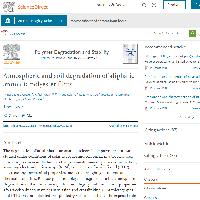Resumen
- The degradation of an aliphatic–aromatic biodegradable polyester film was studied under conditions of solar exposure and soil burial in a tropical area. Film samples were evaluated for changes over 40 weeks by visual examination, scanning electronic microscopy (SEM), Fourier transform infrared (FTIR) spectroscopy, mechanical properties, molecular weight, gel content, and thermal properties. Photodegradation played a major role in the atmospheric degradation of the film, causing it to lose integrity and mechanical properties after week 8 due to main chain scission and crosslinking. SEM micrographs and FTIR spectra indicated that photodegradation started at the exposed side of the film and propagated through the polymer matrix after week 8. FTIR spectra also indicated that subsequent photooxidation processes took place. The reduction of molecular weight of the soil burial samples was much slower than that of the non-crosslinked portion of solar exposed film samples. The reduction of number average molecular weight of the non-crosslinked solar exposed samples followed a first order reaction, whereas the soil burial samples show a surface erosion biodegradation behavior. The relationship among total solar radiation, gel content and number average molecular weight indicated that an accumulated total solar radiation of 800 MJ/m2, reached in approximately 7 weeks at the exposure site, is required for PBAT mulch film integrity loss.
